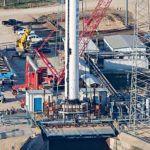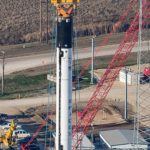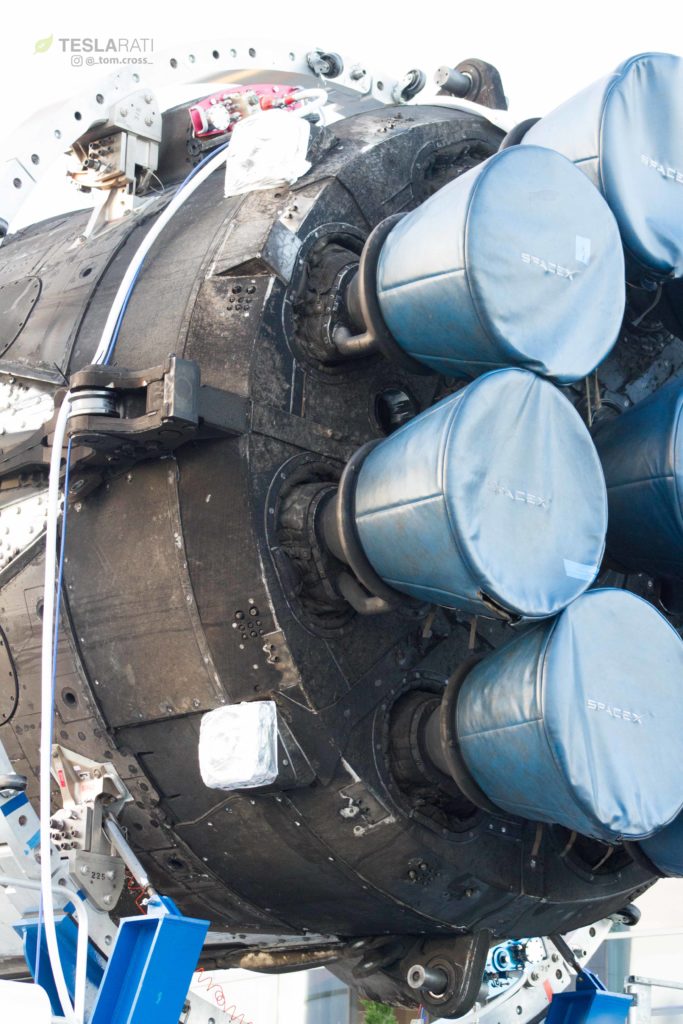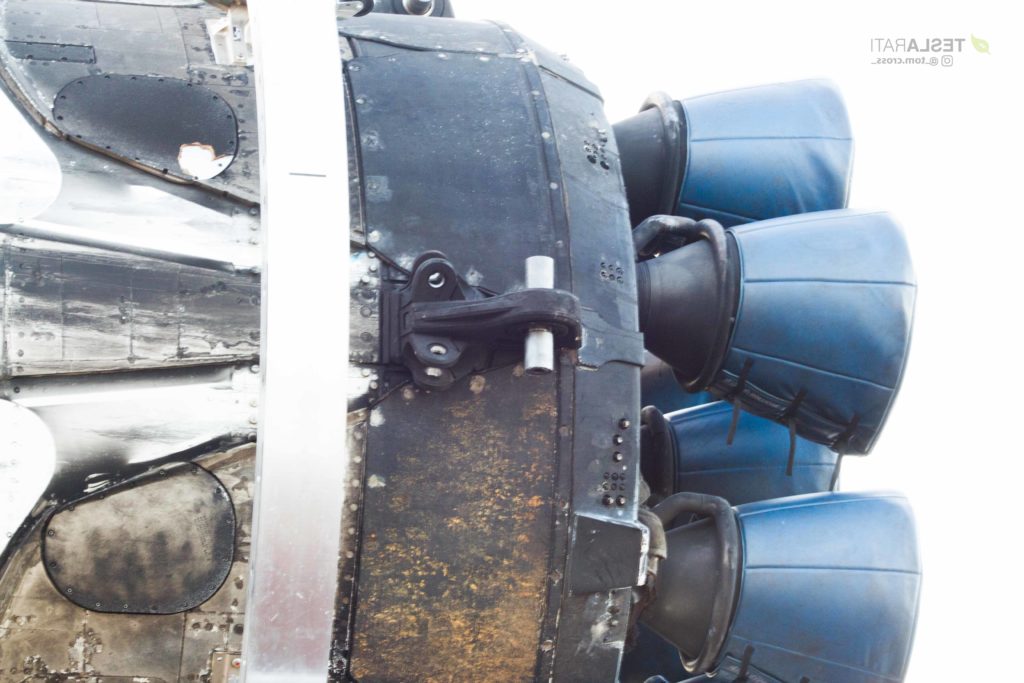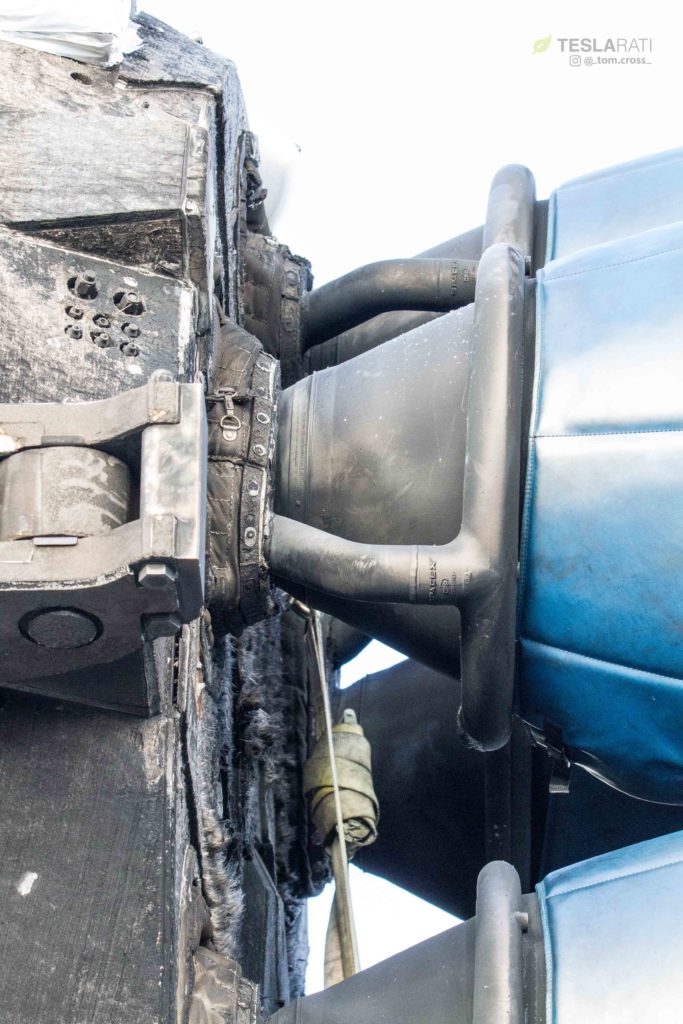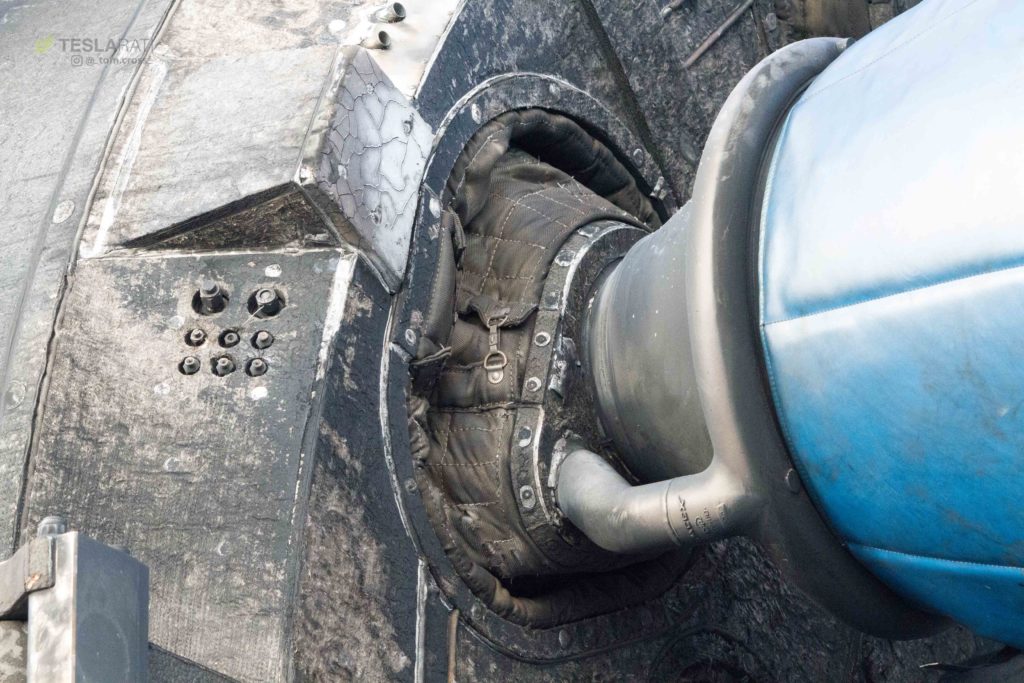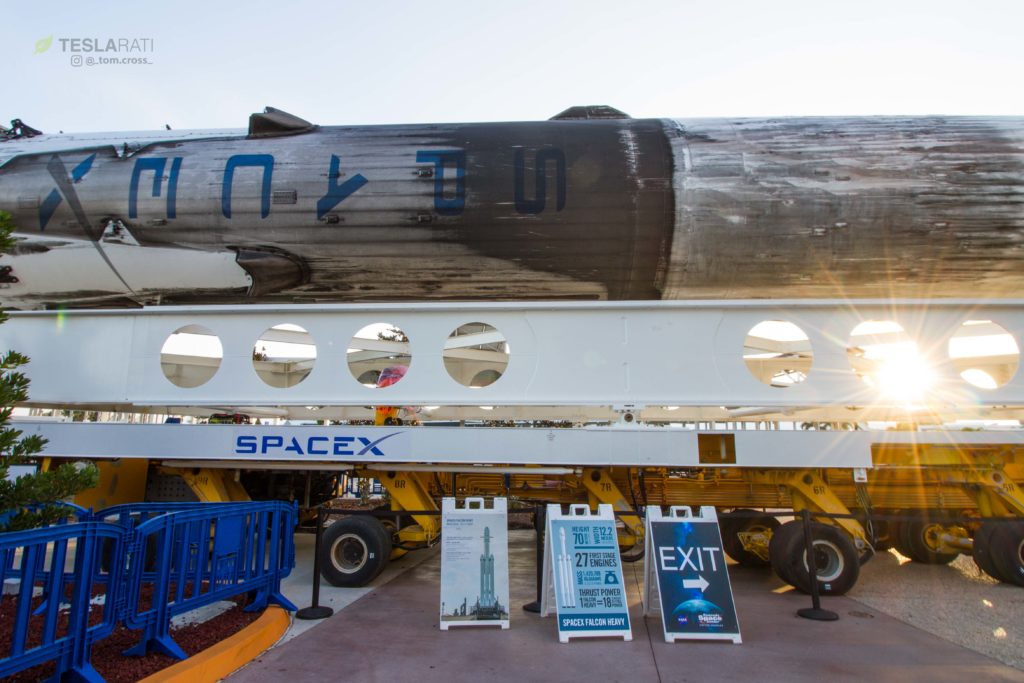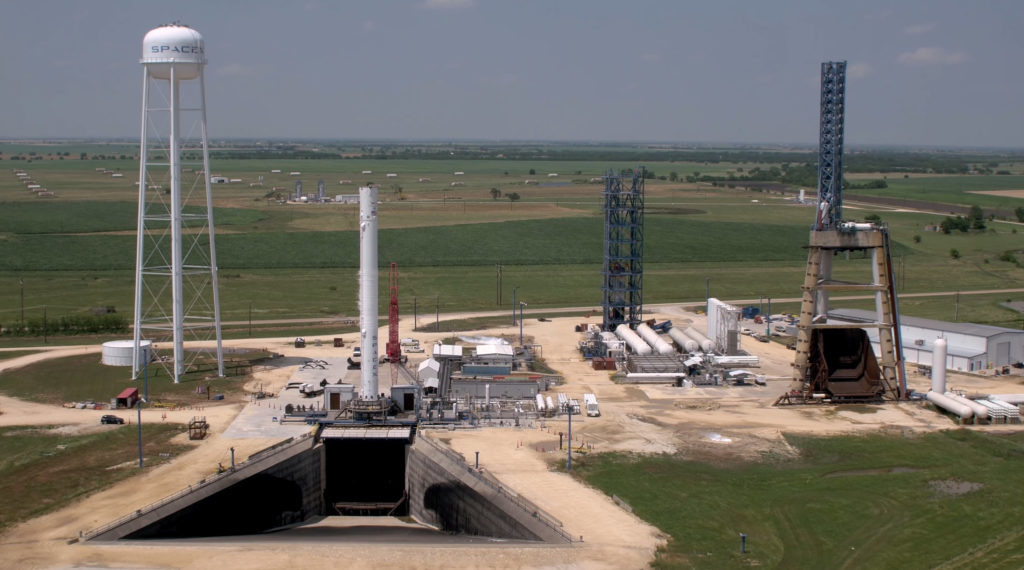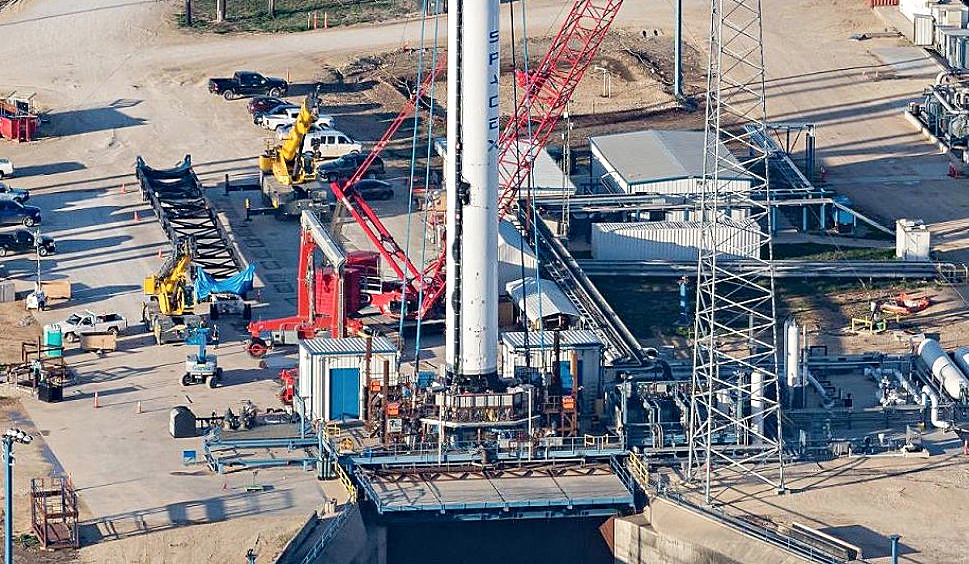
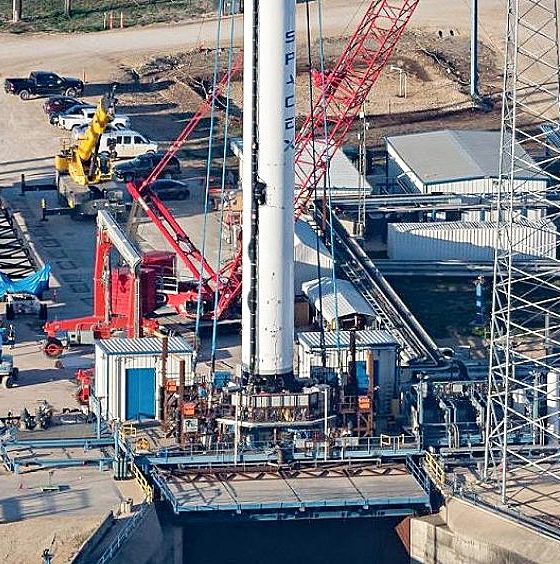
News
SpaceX Falcon 9 “Block 5” next-gen reusable rocket spied in Texas test site
SpaceX’s next and final generation of Falcon rockets is nearly ready to complete its biggest milestone yet, second only to operational launch. Known as Falcon 9 Block 5, the upgraded booster arrived at SpaceX’s McGregor, TX test facilities and went vertical on the static fire test stand.
Now vertical, that first integrated static fire is likely to occur within a handful of days at most. Once complete, assuming the data it produces do not betray any bugs or serious problems, the booster will be brought horizontal and transported to one of SpaceX’s three launch facilities for its first operational mission.
Why Block 5?
With nary a hint of hyperbole, it’s safe to say that Falcon 9 Block 5 will be the most significant piece of hardware ever developed and fielded by SpaceX. The reason lies in many of the changes and upgrades present in this newest iteration of the rocket. While Falcon 9 B5 and its similarly upgraded Merlin 1D engines include design changes intended to satisfy NASA requirements before SpaceX can be certified to launch humans, the brunt of the upgrades are laser-focused on ease and speed of reusability.
- SpaceX Block 5 Falcon9 at McGregor, Texas [Credit: Chris G – NSF via Twitter, Reprinted with permission from NASASpaceflight.com]
- SpaceX Block 5 Falcon9 at McGregor, Texas [Credit: Chris G – NSF via Twitter, Reprinted with permission from NASASpaceflight.com]
- SpaceX Block 5 Falcon9 at McGregor, Texas [Credit: Chris G – NSF via Twitter, Reprinted with permission from NASASpaceflight.com]
Photo courtesy of Chris G at nasaspaceflight.com via Twitter. Reprinted with permission.
The goal with those upgrades, as publicly stated by numerous SpaceX executives, is to enable as many as 10 flights with a bare minimum of refurbishment and 100 or more launches with intermittent maintenance. To achieve those titanic aspirations, SpaceX has gathered a flood of data and experience earned through the recovery of nearly 20 Falcon 9 and Heavy boosters, as well as the successful reflight and second recovery of several of those same boosters. With that data in hand, the company’s launch vehicle engineers optimized and upgraded the rocket’s design to combat the worst of the extreme forces each booster is subjected to while returning to land (or sea).
- Falcon Heavy side booster B1025 gives a sense of the sheer brutality of reentry conditions. (Tom Cross)
- Note the pieces of cork that have been torn off by the buffeting and heat on the lefthand side. (Tom Cross)
- An incredibly detail shot of the side of the octaweb. The large chunk of smooth metal in the center is actually one of the booster’s connection points to the Falcon Heavy center core. (Tom Cross/Teslarati)
- A beautiful capture of one of the booster’s nine Merlin engines, showing off the pipe used to cool the engine bell, as well as the ceramic blanket that protects its more sensitive plumbing. (Tom Cross/Teslarati)
As evidenced by photos taken by Gary Blair, one of NASASpaceflight.com‘s most renowned L2 forum contributors, many of the visible differences between Block 5 and previous versions of Falcon 9 are a result of drastically improved and expanded heat shielding of its most sensitive and crucial components. While Falcon 9 B5’s black sections by all appearances look like naked carbon fiber composite, they are likely to be coated with an incredibly heat-resistant material known a Pyron. Portions of the booster that suffer from incidental scorching and extreme heating (aside from the octaweb) appear to have been treated with this material, including a pathway down the side of the rocket known as a raceway. The raceway is a protective enclosure for a variety of cabling and piping, essentially the rocket’s nervous system as well as the home of several the cold gas thrusters it uses to orient itself outside of Earth’s atmosphere.
In the past, SpaceX has used high-quality cork as a quasi-ablative thermal protection system for those same components, including the payload fairing. A major downside of cork, however, is that it is very ablative and tends to come off rather haphazardly in large chunks, all of which must either be spot-fixed or replaced entirely before a booster reflight. By replacing that cork with Pyron or a similar internally-developed material, those sensitive Falcon components may be almost totally insulated from and resistant to temperatures as high as 2300 °F (1200 °C)
- Block 5 looks similar to this Falcon 9, but with a deep black interstage and a black enclosure instead of the white covering seen running down the left side of the booster. (SpaceX)
Titanium grid fins are another central feature of Block 5, acting as a near-indefinitely reusable replacement for the aluminum grid fins SpaceX has traditionally used. Put through a huge amount of heating during reentry; aluminum grid fins have famously appeared to partially melt during some of the hottest booster recovery attempts. Titanium, a metal with a much higher melting point, will have no such problems, does not need ablative white paint, and certainly appear all but untouched by reentry in the cases of both their June 2017 debut and second flight on Falcon Heavy’s side boosters.
Finally and perhaps most importantly, is the octaweb – the assembly at the base of Falcon 9 responsible for safely transmitting nearly two million pounds of thrust from its nine Merlin 1Ds to the rest of the rocket’s structure, while also taking the brunt of the heat of reentry. Before Block 5, the octaweb was protected from that heating with an ablative thermal protection system, likely around 80% cork and 20% PICA-X, the same material used on Cargo Dragon’s heat shield. Based on comments made privately by individuals familiar with SpaceX, that ablative shielding is to be replaced by a highly heat-resistant metal alloy known as inconel. By ridding Block 5 of ablative heat shielding, SpaceX will no longer have to carefully examine and replace those materials after each launch, removing one of the biggest refurbishment time-sinks.

Titanium grid fins complete the highly reusable changes to Block 5 of Falcon 9. (NASA)
Combined, these various upgrades are intended to enable Falcon 9’s first stage to be reused almost effortlessly compared to previous iterations. With this vehicle, including the reusable fairing debuted on the launch of PAZ, SpaceX may well be able to achieve Elon Musk’s famous goal of lowering the cost of launch by nearly an order of magnitude. While SpaceX will likely use that cost reduction to first recoup its considerable investments in reusability and Falcon Heavy, major price drops may reach customers soon after. This Falcon 9, in particular, is unlikely to launch for another month or so, but when it does, it is perhaps the biggest step SpaceX has yet taken on the path to routine, rapid, and affordable access to orbit.
Teslarati – Instagram – Twitter
Tom Cross – Twitter
Pauline Acalin – Twitter
Eric Ralph – Twitter

News
Tesla Diner becomes latest target of gloom and doom narrative

The Tesla Diner has been subject to many points of criticism since its launch in mid-2025, and skeptics and disbelievers claim the company’s latest novel concept is on its way down, but there’s a lot of evidence to state that is not the case.
The piece cites anecdotal evidence like empty parking lots, more staff than customers during a December visit, removed novelty items, like Optimus robot popcorn service and certain menu items, the departure of celebrity chef Eric Greenspan in November 2025, slow service, high prices, and a shift in recent Google/Yelp reviews toward disappointment.
The piece frames this as part of broader Tesla struggles, including sales figures and Elon Musk’s polarizing image, calling it a failed branding exercise rather than a sustainable restaurant.
This narrative is overstated and sensationalized, and is a good representation of coverage on Tesla by today’s media.
Novelty Fade is Normal, Not Failure
Any hyped launch, especially a unique Tesla-branded destination blending dining, Supercharging, and a drive-in theater, naturally sees initial crowds taper off after the “Instagram effect” wears down.
Tesla makes major change at Supercharger Diner amid epic demand
This is common for experiential spots in Los Angeles, especially pop-up attractions or celebrity-backed venues. The article admits early success with massive lines and social media buzz, but treats the return to normal operations as “dying down.”
In reality, this stabilization is a healthy sign of transitioning from hype-driven traffic to steady patronage.
Actual Performance Metrics Contradict “Ghost Town” Claims
- In Q4 2025, the Diner generated over $1 million in revenue, exceeding the average McDonald’s location
- It sold over 30,000 burgers and 83,000 fries in that quarter alone. These figures indicate a strong ongoing business, especially for a single-location prototype focused on enhancing Supercharger experiences rather than competing as a mass-market chain
It’s not a ghost town lol. The @Tesla Diner still had over 30,000 burger orders and 83,000 fries orders in Q4. The diner generated over $1M in revenue in Q4, a $4M annual run rate, which is more than the average McDonald’s…. pic.twitter.com/XvAGLUqxej
— Sawyer Merritt (@SawyerMerritt) January 4, 2026
Conflicting On-the-Ground Reports
While the article, and other similar pieces, describe a half-full parking lot and sparse customers during specific off-peak visits, other recent accounts push back:
- A January 2026 X post noted 50 of 80 Supercharger stalls were busy at 11 a.m., calling it “the busiest diner in Hollywood by close to an order of magnitude
TESLA DINER 🍔
Frantic!!!
Crazy busy. pic.twitter.com/wMbmr8SFFn
— Rich & Sharon (@HullTeslaModel3) January 4, 2026
- Reddit discussions around the same time describe it as not empty when locals drive by regularly, with some calling the empty narrative “disingenuous anti-Tesla slop.”
When we visited it last week it was packed. We had to wait to enter, get a table and go to the restroom. We were lucky to find a spot to charge.
— Rani G (@ranig) January 4, 2026
Bottom Line
The Tesla Diner, admittedly, is not the nonstop circus it was at launch–that was never sustainable or intended. But, it’s far from “dying” or an “empty pit stop.”
It functions as a successful prototype: boosting Supercharger usage, generating solid revenue, and serving as a branded amenity in the high-traffic EV market of Los Angeles.
News
Tesla stands to win big from potential adjustment to autonomous vehicle limitations
Enabling scale, innovation, and profitability in a sector that is growing quickly would benefit Tesla significantly, especially as it has established itself as a leader.

Tesla stands to be a big winner from a potential easing of limitations on autonomous vehicle development, as the United States government could back off from the restrictions placed on companies developing self-driving car programs.
The U.S. House Energy and Commerce subcommittee will hold a hearing later this month that will aim to accelerate the deployment of autonomous vehicles. There are several key proposals that could impact the development of self-driving cars and potentially accelerate the deployment of this technology across the country.
These key proposals include raising the NHTSA’s exemption cap from 2,500 to 90,000 vehicles per year per automaker, preempting state-level regulations on autonomous vehicle systems, and mandating NHTSA guidelines for calibrating advanced driver assistance systems (ADAS).
Congress, to this point, has been divided on AV rules, with past bills like the 2017 House-passed measure stalling in the Senate. Recent pushes come from automakers urging the Trump administration to act faster amid competition from Chinese companies.
Companies like Tesla, who launched a Robotaxi service in Austin and the Bay Area last year, and Alphabet’s Waymo are highlighted as potential beneficiaries from lighter sanctions on AV development.
The NHTSA recently pledged to adopt a quicker exemption review for autonomous vehicle companies, and supporters of self-driving tech argue this will boost U.S. innovation, while critics are concerned about safety and job risks.
How Tesla Could Benefit from the Proposed Legislation
Tesla, under CEO Elon Musk’s leadership, has positioned itself as a pioneer in autonomous driving technology with its Full Self-Driving software and ambitious Robotaxi plans, including the Cybercab, which was unveiled in late 2024.
The draft legislation under consideration by the U.S. House subcommittee could provide Tesla with significant advantages, potentially transforming its operational and financial landscape.
NHTSA Exemption Cap Increase
First, the proposed increase in the NHTSA exemption cap from 2,500 to 90,000 vehicles annually would allow Tesla to scale up development dramatically.
Currently, regulatory hurdles limit how many fully autonomous vehicles can hit the roads without exhaustive approvals. For Tesla, this means accelerating the rollout of its robotaxi fleet, which Musk envisions as a network of millions of vehicles generating recurring revenue through ride-hailing. With Tesla’s vast existing fleet of over 6 million vehicles equipped with FSD hardware, a higher cap could enable rapid conversion and deployment, turning parked cars into profit centers overnight.
Preempting State Regulations
A united Federal framework would be created if it could preempt State regulations, eliminating the patchwork of rules that currently complicate interstate operations. Tesla has faced scrutiny and restrictions in states like California, especially as it has faced harsh criticism through imposed testing limits.
A federal override of State-level rules would reduce legal battles, compliance costs, and delays, allowing Tesla to expand services nationwide more seamlessly.
This is crucial for Tesla’s growth strategy, as it operates in multiple markets and aims for a coast-to-coast Robotaxi network, competing directly with Waymo’s city-specific expansions.
Bringing Safety Standards to the Present Day
Innovation in the passenger transportation sector has continued to outpace both State and Federal-level legislation, which has caused a lag in the development of many things, most notably, self-driving technology.
Updating these outdated safety standards, especially waiving requirements for steering wheels or mirrors, directly benefits Tesla’s innovative designs. Tesla wanted to ship Cybertruck without side mirrors, but Federal regulations required the company to equip the pickup with them.
Cybercab is also planned to be released without a steering wheel or pedals, and is tailored for full autonomy, but current rules would mandate human-ready features.
Streamlined NHTSA reviews would further expedite approvals, addressing Tesla’s complaints about bureaucratic slowdowns. In a letter written in June to the Trump Administration, automakers, including Tesla, urged faster action, and this legislation could deliver it.
In Summary
This legislation represents a potential regulatory tailwind for Tesla, but it still relies on the government to put forth action to make things easier from a regulatory perspective. Enabling scale, innovation, and profitability in a sector that is growing quickly would benefit Tesla significantly, especially as it has established itself as a leader.
News
Nvidia CEO Jensen Huang explains difference between Tesla FSD and Alpamayo
“Tesla’s FSD stack is completely world-class,” the Nvidia CEO said.

NVIDIA CEO Jensen Huang has offered high praise for Tesla’s Full Self-Driving (FSD) system during a Q&A at CES 2026, calling it “world-class” and “state-of-the-art” in design, training, and performance.
More importantly, he also shared some insights about the key differences between FSD and Nvidia’s recently announced Alpamayo system.
Jensen Huang’s praise for Tesla FSD
Nvidia made headlines at CES following its announcement of Alpamayo, which uses artificial intelligence to accelerate the development of autonomous driving solutions. Due to its focus on AI, many started speculating that Alpamayo would be a direct rival to FSD. This was somewhat addressed by Elon Musk, who predicted that “they will find that it’s easy to get to 99% and then super hard to solve the long tail of the distribution.”
During his Q&A, Nvidia CEO Jensen Huang was asked about the difference between FSD and Alpamayo. His response was extensive:
“Tesla’s FSD stack is completely world-class. They’ve been working on it for quite some time. It’s world-class not only in the number of miles it’s accumulated, but in the way it’s designed, the way they do training, data collection, curation, synthetic data generation, and all of their simulation technologies.
“Of course, the latest generation is end-to-end Full Self-Driving—meaning it’s one large model trained end to end. And so… Elon’s AD system is, in every way, 100% state-of-the-art. I’m really quite impressed by the technology. I have it, and I drive it in our house, and it works incredibly well,” the Nvidia CEO said.
Nvidia’s platform approach vs Tesla’s integration
Huang also stated that Nvidia’s Alpamayo system was built around a fundamentally different philosophy from Tesla’s. Rather than developing self-driving cars itself, Nvidia supplies the full autonomous technology stack for other companies to use.
“Nvidia doesn’t build self-driving cars. We build the full stack so others can,” Huang said, explaining that Nvidia provides separate systems for training, simulation, and in-vehicle computing, all supported by shared software.
He added that customers can adopt as much or as little of the platform as they need, noting that Nvidia works across the industry, including with Tesla on training systems and companies like Waymo, XPeng, and Nuro on vehicle computing.
“So our system is really quite pervasive because we’re a technology platform provider. That’s the primary difference. There’s no question in our mind that, of the billion cars on the road today, in another 10 years’ time, hundreds of millions of them will have great autonomous capability. This is likely one of the largest, fastest-growing technology industries over the next decade.”
He also emphasized Nvidia’s open approach, saying the company open-sources its models and helps partners train their own systems. “We’re not a self-driving car company. We’re enabling the autonomous industry,” Huang said.

